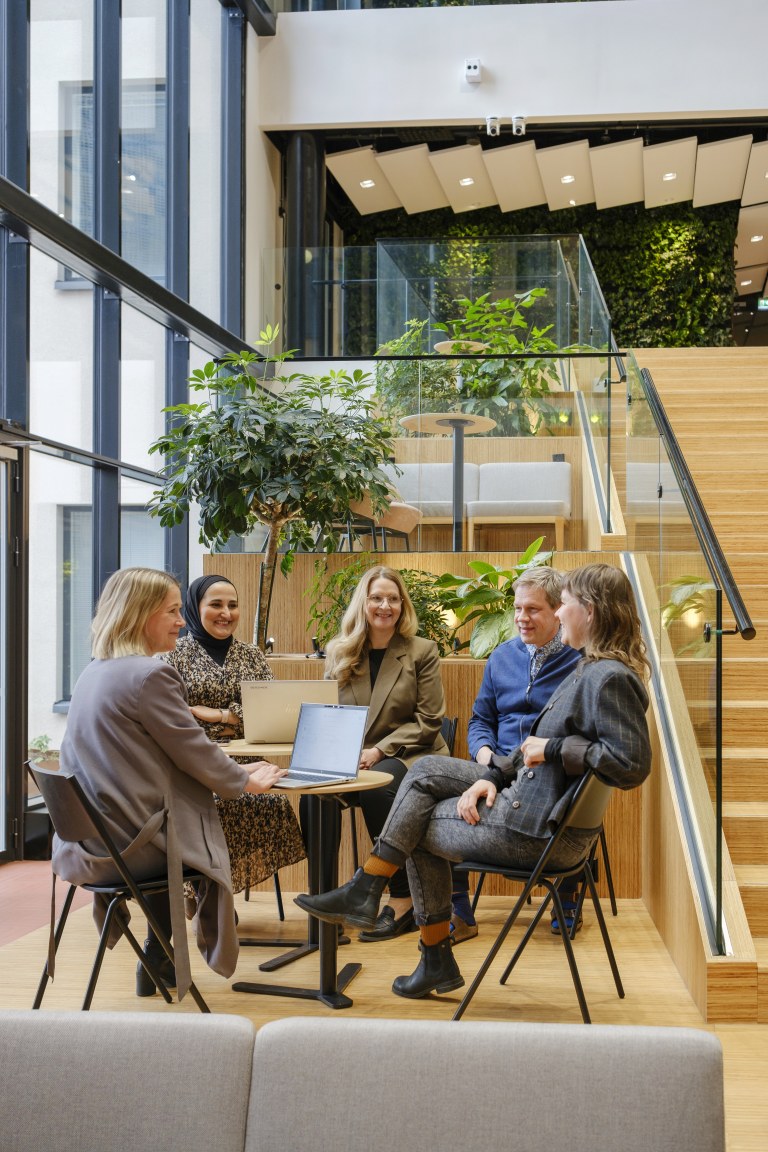
About three years ago, engineering and consulting company Sweco began to seriously consider what diversity means for the company. What makes a work community inclusive to all, and how could this be promoted?
“We are a large organisation, and this became a topic of discussion. We were starting to have so many non-Finnish speakers, for example, that the question of language came up. This was something we had to work on,” says HR Director Sari Metsänen.
The management team decided that people who do not speak Finnish should also be able to work at Sweco. The company provided more opportunities to participate in English, for example by producing internal communication in English as well as Finnish.
Sweco has approximately 3,000 employees in Finland. Metsänen works at the Ilmala office in Helsinki, which has 1,200 workstations. Sweco is headquartered in Sweden and the company employs 22,000 architects, engineers and other experts worldwide.
The management team also recognised the male dominance within the company and announced that it wants to increase the number of women in the company. The goal is for 30 per cent of the workforce to be women by 2026.
“We are monitoring the development of the number of women and how many women we have in supervisory and project management positions,” says Metsänen.
She has noticed that when there is a metric in place, more attention is usually paid to whatever is being measured. Of all the company’s equality-related goals, increasing the share of women has also sparked critical debate within Sweco.
“Obviously, the goal does not mean that we will only recruit women. Gender is not a recruitment criterion. We will simply ensure that women are considered when filling vacancies.”
Metsänen says that the goal is for all employees, regardless of gender, to enjoy working at Sweco and feel like part of the community.
“We ensure that our practices do not hinder career progression and that everyone can succeed.”
Metsänen monitors the achievement of this goal through personnel surveys and by discussing the topic with employees and employee representatives.
In addition, Sweco’s management team identified a third area for development: taking into account employees of different ages. The team discussed developing the skills of employees of all ages and, for example, providing mentoring opportunities.
Neurodiversity resonates widely
According to Sari Metsänen, an important step in pursuing diversity is to form an understanding of the priorities of the company. Once Sweco had identified its key development areas, namely language, gender and age issues, it established a Diversity network.
The network is open to all Sweco employees, and it met eight times in 2024. The network will continue working this year. The meetings always have a theme related to DEI work.
DEI is an acronym that stands for diversity, equity and inclusion.
One theme that has resonated widely throughout the organisation is neurodiversity. Metsänen says that the suggestion for the theme came from personnel. An individual employee shared their own experience of belonging to a neurominority.
“We realised that this is an important topic for us and it sparked a lot of discussion. This is a great example of how DEI themes are not always born around the management table,” says Metsänen.
Sweco established a neurodiversity group for its employees. The group is led by a professional coach. Sweco’s neurodiversity work earned the company second place in Oikotie’s 2024 competition for responsible acts in work life (työelämän vastuullisuusteko).
DEI work will continue
Sari Metsänen admits that DEI is a long-term, time-consuming process. However, results are already visible. According to Metsänen, some applicants mention Sweco’s work on behalf of diversity when applying for a job at the company.
“We monitor our external employer image and can see that it has developed in a positive direction. We believe that our DEI work plays a role in this. Our external employer image is important, because we want to ensure that we attract the best talent in the industry.”
The article continues after the image.

Metsänen mentions that Sweco’s personnel surveys have produced fairly good results.
“When it comes to DEI, having a good average score is not necessarily the key. We strive to focus our efforts on those whose responses indicate that the situation is not good.”
Under President Trump’s policies, US companies have begun to cut back on DEI programmes. Metsänen assures that Sweco is doing nothing of the sort.
“We believe that building an inclusive work community is important. There is plenty of work to be done; we are not there yet,” she says.
Sweco has a DEI strategy, which Metsänen presents, and which is decided by the management of the company. Sweco will be updating its strategy this year.
“Our goal is for everyone to feel that they can be themselves at work. Management commitment is extremely important, as is engaging personnel.”
You can always turn to the shop steward
Harri Laakso believes that there is not too much talk about equity and equality at Sweco. He works as a structural engineer at the company and serves as a shop steward in the Industry and Energy Division. Sweco has a total of 25 shop stewards.
“Workplaces will become more diverse, and this is something we cannot ignore,” he says.
Laakso believes that supervisors play a key role – they shape the culture of the work community.
“We do things according to requirements, but there is quite a lot of bureaucracy and even empty rhetoric. Although we have a DEI strategy available on the intranet, what is the right way to communicate it and put it into practice? As a shop steward, I can remind supervisors about making an effort and setting an example every day.”
Laakso has been a shop steward since summer 2020. He works at the company’s Ilmala office in Helsinki and feels that there is more diversity and related activities there than in smaller offices.
“I have seen notices on the intranet about peer groups for sexual minorities,” he gives as an example.
In Laakso’s experience, Sweco has succeeded in increasing the representation of women and non-Finnish speakers in its workforce. He believes that this is easier in the capital region where there are more, and more diverse, applicants.
“Increasing diversity cannot be an end in itself, if there are no applicants.”
Last year, Sweco’s shop stewards took part in neurodiversity work. For example, the renovation of the Ilmala office was designed to take into account the needs of neurodivergent employees.
Every year, representatives of the shop stewards review the work community development plan with Sweco’s management. This includes an equality and non-discrimination plan. In addition to this, Laakso would like to see more active communication from management.
If an employee has concerns or problems regarding diversity, Laakso encourages them to contact him or one of the other shop stewards.
“There have been a few cases, but we have managed to resolve them.”
Laakso believes that everyone can contribute to a more inclusive work community through good manners, such as greeting one another, making friendly gestures and having small conversations during the workday.
“Our industry has been through some difficult years financially, and remote work has become more common. It is quieter in the office than it was before COVID. We cannot afford to have employees become isolated from each other. Teams calls are often strictly about business, but organic, everyday encounters in the hallway still matter. Talking about things other than work actually improves wellbeing at work.”

Implementing DEI – where to begin?
DEI stands for Diversity, Equity and Inclusion. In short, DEI is about how these three things are promoted in an organisation.
The goal of DEI work is the wellbeing of all personnel and each individual, the sustainable development of the company and good productivity. In order to carry out this work in an organisation, it is important to know the employees, the organisational culture and all the practices and approaches related to employees.
Here are five tips to help you get started with DEI work. You can also apply them if it feels like your organisation has not made sufficient progress through previous measures.
1. Identify your organisation's DEI challenges. Ask questions, audit, educate.
2. Measure and monitor data transparently. The results of DEI work become visible over the long term.
3. Allocate sufficient resources, share responsibility.
4. Choose an expert partner. Ask for tips from other organisations in your field.
5. Get your whole organisation involved.
Read more: www.tek.fi/dei-work
Text: Sirkku Pohja
TEK’s work life expert, equality, equity and occupational safety
Boring Pink network
Equality in work life can also be promoted outside the workplace. The Boring Pink network aims to promote the networking of LGBTQA+ people in work life, help them with their career development and job search, and create resources owned by the minority community itself for promoting equality in work life.
Follow the Boring Pink network on LinkedIn: www.linkedin.com/company/boringpink/